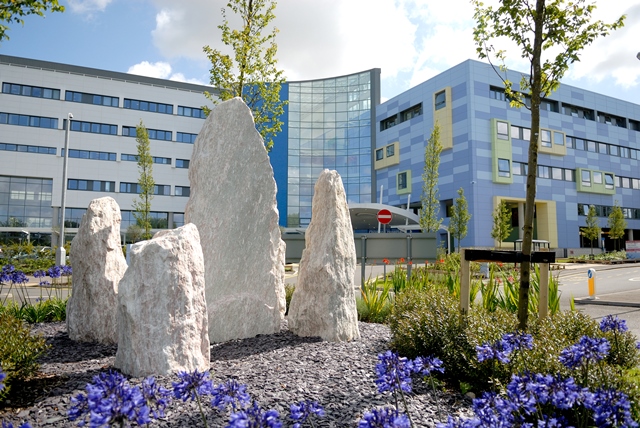A study at Oxford University Hospitals (OUH) NHS Foundation Trust has revealed the different levels of risk faced by healthcare workers dealing with the COVID-19 pandemic.

In a major collaboration with the University of Oxford, almost 10,000 staff were tested both for presence of the virus responsible for COVID-19 and antibodies to the virus. In combination these tests give an accurate view of who has had coronavirus infection to date in the OUH workforce.
Many of the researchers involved in the study are supported by the NIHR Oxford Biomedical Research Centre.
There have been many studies looking at COVID-19 in healthcare workers, but this study, released today in a medRxiv preprint, is the first to comprehensively investigate all staff groups across an institution, and combines data from both symptomatic and asymptomatic staff testing programmes.
The programme was able to
- identify and isolate staff members who had the infection before they developed symptoms, preventing them passing infection on to other staff and patients
- identify in which areas of the hospital staff were at greatest risk
- identify which staff groups were at greatest risk
- record which staff have antibodies to the virus that causes COVID-19, enabling these staff to be monitored to understand if these antibodies provide immunity against repeat infections.
Based on the findings of the testing, OUH was able to implement an infection prevention and control plan to limit transmission of the virus.
OUH Chief Executive Dr Bruno Holthof said: “Since the outbreak of COVID-19, the University and the Trust have pooled resources to develop highly reliable PCR and antibody testing to support the research and care in the fight against the virus.
“Thanks to the infectious diseases and microbiology teams, research nurses and medical students who worked tirelessly to collect more than 20,000 samples, we now have a detailed view of the infection prevalence in our staff. Thank you very much to all who have contributed to this great effort.”
It has previously been shown that healthcare staff are at greater risk of COVID-19 infection than the general population. The OUH study has now demonstrated that this risk is not borne evenly among hospital staff.
The results of the testing showed that 11% of staff had had COVID-19 at some stage. However this figure rose to 21% of staff working on COVID-19 wards.
The figures show that Black, Asian and minority ethnic (BAME) staff were at greater risk of infection than their colleagues. The overall figure for COVID-19 infection among BAME staff was 14.7%, compared to 8.7% for white staff. This figure rose to 17% for Black and Asian staff.
The departments in which staff work also played a role in their chances of contracting the virus. While those working in Intensive Care and the Emergency Department had infection rates of 9.9% and 12.1% respectively, the figure in Acute Medicine was 27.4%, and among porters and cleaners 18%.
OUH’s Director of Infection Prevention and Control, Dr Katie Jeffery, said: “The collection of samples on this scale has been a team effort, both by those taking the samples and those being tested. The work of the sampling team has been amazing, and I would like to thank our staff, who have engaged in such large numbers with coming to appointments to be tested.
“It has been an invaluable exercise to have evidence of the varying patterns of infection across our four hospitals – not only to identify those staff who had the infection and so protect staff and patients, but also to identify those staff groups and departments that are at highest risk. We are continuing to offer testing to our staff to keep them and our patients safe.
“A whole bundle of measures were brought in to protect staff and patients, so it is difficult to know exactly which factors were most important in this outcome. This research will be useful as we move forward, as we assess whether those staff with antibodies retain their immunity to the virus,” Dr Jeffery added.
OUH’s Chief People Officer, Terry Roberts, said: “This research, based on a comprehensive staff testing effort, has been useful in helping us to identify which staff groups are most at risk.
“From an early stage in the pandemic we have tried our best to put in place proactive measures to protect our all of our staff, whether through the provision of appropriate PPE, mandatory risk assessments by line managers and clear and timely communications – and this has included those working for outsourcing companies and agencies, such as porters, cleaners, catering and estates staff, whom we consider to be part of the OUH team, and whose health and wellbeing is just as important as that of staff employed directly by the Trust.
“The Trust also put in place special steps to ensure that all BAME staff working at OUH feel safe and supported, including adding them to the ‘at risk’ group and advising managers on how they can ensure any risks are mitigated. We also set up listening sessions to ensure that BAME staff could highlight any concerns they had.”
An infection prevention and control plan was implemented across the Trust as a result of the testing programme to try to minimise the spread of COVID-19 among staff and patients.
Prof Meghana Pandit, OUH’s Chief Medical Officer, explained: “We have drawn up recommendation for all staff across our four hospital sites, including portering and cleaning colleagues.
“This has included staff continuing to use level 1 PPE for all patient contacts, and reinforcing PPE-focused training and safety huddles; ensuring strict social distancing and mask-wearing for patients and staff; continuing to triage patients according to symptoms of possible COVID, including atypical presentations in the elderly; reviewing cleaning procedures and maximising OUH’s rapid diagnostics and lab capacity.”